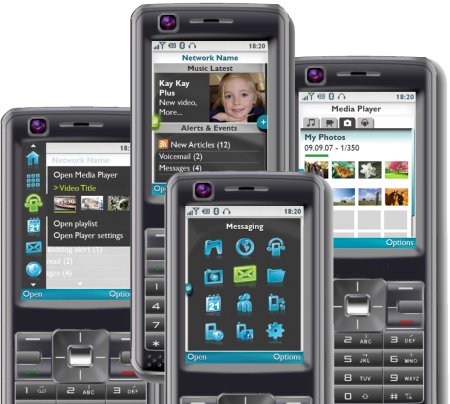Linux mobile stack adds Flash
Sep 10, 2008 — by Eric Brown — from the LinuxDevices Archive — 2 views [Updated Sep. 15] — Azingo says it has integrated Adobe Flash Lite 3.1 web multimedia technology into the browser in its LiMo-compliant Linux stack for phones and mobile devices. The integration means Flash developers can write animated web and video applications for the platform, says Azingo.
[Updated Sep. 15] — Azingo says it has integrated Adobe Flash Lite 3.1 web multimedia technology into the browser in its LiMo-compliant Linux stack for phones and mobile devices. The integration means Flash developers can write animated web and video applications for the platform, says Azingo.
(Click for larger view of Azingo Mobile screen)
Azingo, formerly Celunite, launched its Linux-based Azingo Mobile middleware and browser stack prior to February's Mobile World Congress in Barcelona. Azingo Mobile is positioned as a comprehensive software/services offering for mid-tier feature-phones compliant with LiMo (Linux Mobile Foundation) requirements. The company is contributing some high-level tools to LiMo's common integration environment (CIE). Based in Silicon Valley, Azingo has development offices throughout India, and employs about 250 engineers.

Different views of Azingo Mobile
(Click to enlarge)
The Flash Lite integration enables customers of handsets that offer the Azingo Mobile browser to view “rich Flash-based content offering advanced browsing of most Flash-based websites” and display “animations and Flash Player compatible videos,” says Azingo. The company has yet to announce any handset wins. However, in a July interview with the Economic Times, in conjunction with the formal launch of Azingo Mobile, Azingo CEO Mahesh Veerina was quoted as saying his company had “established relationships with six of the top base-band providers and four top global mobile operators.”

Azingo Mobile architecture
(Click to enlarge)
Adobe in May announced an “Open Screen Project” intended to remove restrictions on Flash file formats, to open Flash server protocols, and to give away the player along with the APIs (application programming interfaces) needed to port it to new devices. Although versions of the Flash Player for desktop operating systems have been free, handset manufacturers and other device makers have had to pay a license fee. Azingo's integration with Flash Lite was not developed under the Open Screen Project, but could in time fall under it, a company spokesperson suggested.
Specific elements of Adobe's Open Screen Project include:
- Removing licensing fees, making new releases of the Adobe Flash Player and AIR (Adobe Integrated Runtime) free
- Removing restrictions on the use of the SWF and FLV (flash video) file formats
- Publishing the device-layer APIs for porting Flash to new devices
- Publishing Flash Cast and AMF (action message format), which let Flash applications receive information from remote databases
Stated Gary Kovacs, Adobe VP and GM, Mobile and Devices, “Azingo has provided a fast and comprehensive integration of Flash Lite, opening the world of mobile Linux to Flash developers and enabling rich web browsing experiences for mobile phone users worldwide.”
In 2006, Adobe open-sourced a key ingredient of Flash, the ActionScript scripting engine. Adobe Flash is still not a truly open-source product, as it contains technologies like audio and video codecs that are licensed from others. Open source alternatives to Flash include the Linux-compatible Gnash, an SWF (shockwave flash) player and browser plugin that was released in beta form earlier this year.
This article was originally published on LinuxDevices.com and has been donated to the open source community by QuinStreet Inc. Please visit LinuxToday.com for up-to-date news and articles about Linux and open source.